Aérospatiale SA 330 Puma
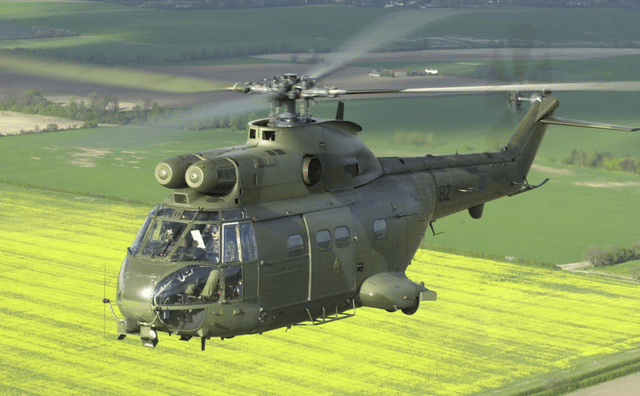
Aérospatiale SA 330 Puma

| SA 330 Puma | |
|---|---|
| A RAF HC1 Puma in flight, 2012 | |
| Role | Utility helicopter |
| National origin | France |
| Manufacturer | Sud Aviation Aérospatiale |
| First flight | 15 April 1965 |
| Introduction | 1968 |
| Status | In service |
| Primary users | French Army Royal Air Force Romanian Air Force Pakistan Army Lebanese Air Force |
| Produced | 1968–1987 |
| Number built | 697 |
| Variants | IAR 330 |
| Developed into | Eurocopter AS332 Super Puma Eurocopter AS532 Cougar Denel Rooivalk Atlas Oryx |
The Aérospatiale SA 330 Puma is a four-bladed, twin-engined medium transport/utility helicopter. The Puma was originally built by Sud Aviation of France, and continued to be made by Aérospatiale. It was also license-built in Romania as the IAR 330; two advanced, unlicensed derivatives, the Denel Rooivalk and Atlas Oryx, were made in South Africa. The Puma was a commercial success and was quickly developed into more advanced models such as the AS332 Super Puma and AS532 Cougar, manufactured by Eurocopter since the early 1990s. These descendants of the Puma remain in production in the 21st century.
The Puma has seen combat in a range of theatres by a number of different operators; significant operations include the Gulf War, the South African Border War, the Portuguese Colonial War, the Yugoslav Wars, the Lebanese Civil War, the Iraq War, and the Falklands War. The type also saw popular use in the civilian field and has been operated by a number of civil operators.
| SA 330 Puma | |
|---|---|
| A RAF HC1 Puma in flight, 2012 | |
| Role | Utility helicopter |
| National origin | France |
| Manufacturer | Sud Aviation Aérospatiale |
| First flight | 15 April 1965 |
| Introduction | 1968 |
| Status | In service |
| Primary users | French Army Royal Air Force Romanian Air Force Pakistan Army Lebanese Air Force |
| Produced | 1968–1987 |
| Number built | 697 |
| Variants | IAR 330 |
| Developed into | Eurocopter AS332 Super Puma Eurocopter AS532 Cougar Denel Rooivalk Atlas Oryx |
Development
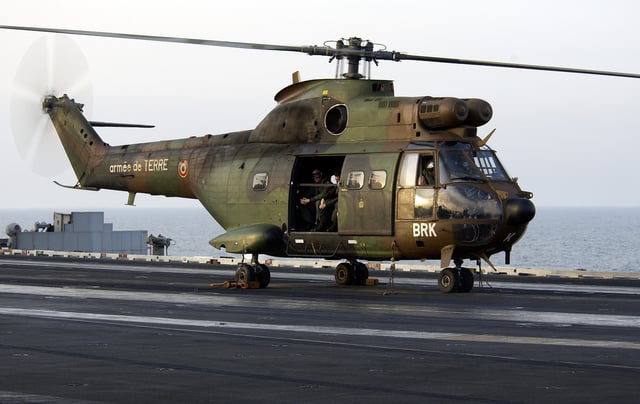
SA 330B Puma, 2004
The SA 330 Puma was originally developed by Sud Aviation to meet a requirement of the French Army for a medium-sized all-weather helicopter capable of carrying up to 20 soldiers as well as various cargo-carrying duties. The choice was made to develop a completely new design for the helicopter, work began in 1963 with backing from the French government.[1] The first of two Puma prototypes flew on 15 April 1965; six further pre-production models were also built, the last of which flew on 30 July 1968. The first production SA 330 Puma flew in September 1968, with deliveries to the French Army starting in early 1969.[2]
In 1967, the Puma was selected by the Royal Air Force (RAF), who were impressed by the Puma's performance. It was given the designation Puma HC Mk 1. A significant joint manufacturing agreement was between Aerospatiale and Westland Helicopters of the UK; the close collaboration between the French and British firms would also result in subsequent purchases of Aérospatiale Gazelle by the United Kingdom and the Westland Lynx by France. Under this agreement, Westland manufactured a range of components for the Puma; additionally it also performed the assembly of Pumas ordered by the RAF.[3][4][5]
The SA 330 was a success on the export market, numerous countries purchased military variants of the Puma to serve in their armed forces; the type was also popularly received in the civil market, finding common usage by operators for transport duties to off-shore oil platforms.[6] Throughout most of the 1970s, the SA 330 Puma was the best selling transport helicopter being produced in Europe.[7] By July 1978, over 50 Pumas had already been delivered to civil customers, and the worldwide fleet had accumulated in excess of 500,000 operational hours.[8]
Romania entered into an arrangement with Aerospatiale to produce the Puma under license as the IAR 330, manufacturing at least 163 of the type for the Romanian armed forces, civil operators, and several export customers of their own.[9] Indonesia also undertook domestic manufacturing of the SA 330.[10] South Africa, a keen user of the type, performed their own major modification and production program conducted by the government-owned Atlas Aircraft to upgrade their own Pumas, the resulting aircraft was named Oryx. In the 1990s, Denel would also develop an attack helicopter for the South African Air Force based on the Puma, known as the Denel Rooivalk.[9]
In 1974, Aerospatiale began development of improved Puma variants, aiming to produce a successor to the type; these efforts would cumulate in the AS332 Super Puma. The first prototype AS332 Super Puma took flight on 13 September 1978, featuring more powerful engines and a more aerodynamically-efficient extended fuselage; by 1980, production of the AS332 Super Puma had overtaken that of the originating SA 330 Puma.[11] Production of the SA 330 Puma by Aérospatiale ceased in 1987,[12] by which time a total of 697 had been sold;[13] production in Romania would continue into the 21st Century.[11]
Design
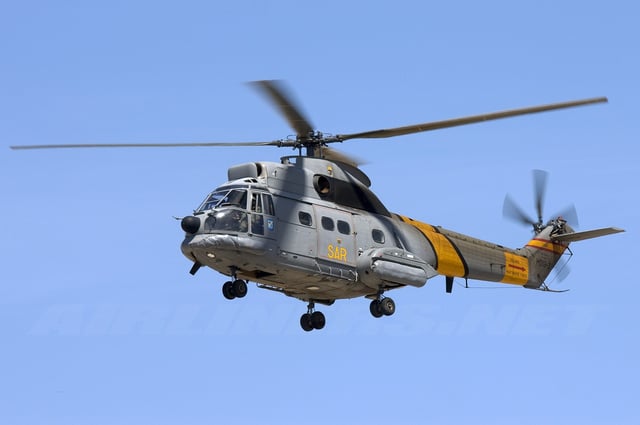
Spanish Air Force SA 300L Puma, 2008
The SA 330 Puma is a twin-engine helicopter intended for personnel transport and logistic support duties. As a troop carrier, up to 16 soldiers can be seated on foldable seats; in a casualty evacuation configuration, the cabin can hold six litters and four additional personnel; the Puma can also perform cargo transport duties, using alternatively an external sling or the internal cabin, with a maximum weight of 2500 kg. Civilian Pumas feature a variety of passenger cabin layouts, including those intended for VIP services. In a search and rescue capacity, a hoist is commonly installed, often mounted on the starboard fuselage.[14]
A pair of roof-mounted Turbomeca Turmo turboshaft engines power the Puma's four-blade main rotor. The helicopter's rotors are driven at a speed of roughly 265 rpm via a five reduction stage transmission. The design of the transmission featured several unique and uncommon innovations for the time, such as single-part manufacturing of the rotor shaft and the anti-vibration measures integrated into the main gearbox and main rotor blades.[15] The Puma also featured an automatic blade inspection system, which guarded against and alerted crews to fatigue cracking in the rotor blades. There are two hydraulic systems on board, these operate entirely independent of one another, one system powers only the aircraft's flight controls while the other serves the autopilot, undercarriage, rotor brake, and the flight controls.[16]
In flight, the Puma was designed to be capable of high speeds, exhibit great maneuverability, and have good hot-and-high performance; the engines have an intentionally high level of reserve power to enable a Puma to effectively fly at maximum weight with only one functioning engine and proceed with its mission if circumstances require.[17] The cockpit has conventional dual controls for a pilot and copilot, a third seat is provided in the cockpit for a reserve crew member or commander. The Puma features a SFIM-Newmark Type 127 electro-hydraulic autopilot; the autopilot is capable of roll and pitch stabilization, the load hook operator can also enter corrective adjustments of the helicopter's position from his station through the autopilot.[18]
The Puma is readily air-transportable by tactical airlift aircraft such as the Transall C-160 and the Lockheed C-130 Hercules; the main rotor, landing gear, and tailboom are all detachable to lower space requirements. Ease of maintenance was one of the objectives pursued in the Puma's design; many of the components and systems that would require routine inspection were positioned to be visible from ground level, use of life-limited components was minimised, and key areas of the mechanical systems were designed to be readily accessed.[14] The Puma is also capable of operating at nighttime, in inhospitable flying conditions, or in a wide range of climates from Arctic to desert environments.[19]
Although not included during the original production run, numerous operators of Pumas have installed additional features and modern equipment over the aircraft's service life. The RAF have equipped their Puma fleet with Global Positioning System (GPS) navigation equipment, along with an assortment of self-defense measures including infrared jammers and automatic flares/chaff dispensers, and night vision goggles for night-time flights.[19] The French Army Light Aviation have modernised their Pumas to meet International Civil Aviation Organization standards, this involved additional digital systems to the aircraft, this has included new mission command and control systems, such as the Sitalat data link.[20] Third party companies such as South Africa's Thunder City have provided life extension and modernisation programmes for the Puma, some operators have chosen to refurbish their fleets with glass cockpits.[21]
Operational history
Argentina
During the Falklands War/Guerra de Malvinas in 1982, five SA 330 Pumas of the Argentine Army and one of the Argentine Coast Guard were deployed to the theatre; these could either operate from the decks of Navy vessels as well as performing missions across the breadth of the islands; all were lost in the ensuing conflict.[22] On 3 April, while landing Argentine troops as part of the capture of South Georgia, a Puma was badly damaged by small arms fire from British ground forces and crashed into terrain shortly after.[23] On 9 May, a single Puma was destroyed by a Sea Dart anti-aircraft missile launched from HMS Coventry.[24] On 23 May, a pair of Royal Navy Sea Harriers intercepted three Argentine Pumas in the middle of a supply mission to Port Howard; during the subsequent engagement one Puma was destroyed by colliding with the terrain and a second was disabled and subsequently destroyed by cannon fire from the Sea Harriers, the third Puma escaped.[25] On 30 May, a Puma was lost in the vicinity of Mount Kent under unknown circumstances, possibly due to friendly fire.[26]
France
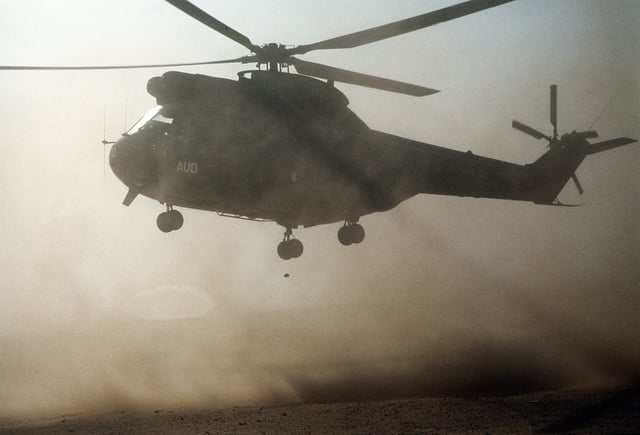
French Puma during Operation Desert Shield, 1990
In September 1979, four Pumas were employed during Operation Barracuda to transport a French assault team directly upon the government headquarters of the Central African Empire; after which confiscated valuables and assorted diplomatic and political records were quickly extracted to the nearby French embassy by continuous air lifts by the Pumas.[27]
One distinctive use of the Puma in French service was as a VIP transport for carrying the President of France both at home and during overseas diplomatic engagements; these duties were transferred to the larger AS332 Super Puma as that became available in sufficient numbers.[28][29]
During the 1991 First Gulf War, France chose to dispatch several Pumas in support of coalition forces engaged in a conflict with Saddam Hussein's Iraq. Those Pumas that had been assigned to the role of performing combat search-and-rescue duties were quickly retrofitted with GPS receivers to enhance their navigational capabilities.[30]
As part of France's contribution to the 1990s NATO-led intervention in the Yugoslav Wars, a number of French Pumas operated in the region alongside other Puma operators such as Britain and the United Arab Emirates; one frequent mission for the type was the vital provision of humanitarian aid missions to refugees escaping ongoing ethnic genocide.[31] In April 1994, a French Puma performed a nighttime extraction of a British SAS squad and a downed Sea Harrier pilot from deep inside hostile Bosnian territory, the aircraft came under small arms fire while retreating from the area.[32][33] On 18 June 1999, a single coordinated aerial insertion of two companies of French paratroopers was performed by 20 Pumas, helping to spearhead the rapid securing of Kosovska Mitrovica by NATO ground forces.[34]
As of 2010, both the French Army and French Navy have opted to procure separate variants of the NHIndustries NH90 to ultimately replace the Puma in French military service.[35]
About 20 SA 330 Pumas remain in French Air Force service as of 2016. Two Pumas of Escadron d'Hélicoptères 1/67 'Pyrénées (EH 1/60) were deployed to Chad and Niger from June 2014 as part of Operation Barkhane to disrupt Islamist insurgency in the Sahel region. Initially operation from N'Djamena in Chad, the detachment later moved forwards to Dirkou and Madama in Niger, supporting ground troops and interdicting supply routes for the insurgents. The detachment returned to France in September 2015, being relieved by French Army helicopters.[36]
Lebanon
In 1980–84, the Lebanese Air Force received from France ten SA 330C Pumas to equip its newly raised 9th transport squadron at Beirut Air Base, where it was initially based. In 1983, the squadron was relocated north of the Lebanese capital, with the machines being dispersed in small improvised helipads around Jounieh and Adma for security reasons. On 23 August 1984 a Puma helicopter carrying the Lebanese Armed Forces' Chief-of-staff and commander of the Seventh Brigade, General Nadim al-Hakim and eight other senior military officers crashed in thick fog near Beirut, all passengers and crewmen being killed.[37] On 1 June 1987, the Lebanese Prime-Minister Rachid Karami was assassinated aboard a Puma helicopter en route to Beirut, when a bomb exploded in an attaché case on his lap. Injured in the explosion were Interior Minister Abdullah Rassi and three of the other twelve aides and crewmen on the helicopter, which was severely damaged.[38][39][40] On 17 January 1988, another Puma helicopter crashed in the Mediterranean off the Bouar coast, killing both the pilot Captain Georges Sadaka and the co-pilot Jean Azzi, though their bodies were never found. During the final phase of the Lebanese Civil War, the Puma fleet – now reduced to seven or six helicopters on flying condition[41] – was used in liaison flights with neighboring Cyprus on behalf of General Michel Aoun's interim military government, although fuel shortages and maintenance problems forced their crews to ground them for most of the time until the end of the war on October 1990.[42]
In 2010 UAE donated 7 IAR 330 SM to the Lebanese Air Force.
In 2013, the Lebanese Air Force converted an IAR 330 SM into a helicopter gunship by mounting on hardened side-swivel mounts a single ADEN Mk 4/5 30mm revolver cannon on a modified pod and a pair of SNEB 68mm rocket launchers taken from decommissioned Hawker Hunter FGA.70 and FGA.70A fighter jets. Re-designated SA 330SM, the new Puma gunship version underwent trails on October 10 that same year during aerial maneuvers held in Hamat Air Base.[43]
Morocco
In 1974, Morocco made an agreement with France for the purchase of 40 Puma helicopters for their armed forces.[44] During the 1970s and 1980s, Moroccan Pumas saw combat service against Polisario Front separatists and helped exert greater control over the Western Sahara region; use of air power by Moroccan forces was severely curtailed after several aircraft were lost or damaged due to the presence of Soviet-provided 2K12 Kub anti-aircraft missiles in rebel hands in the early 1980s.[45]
In October 2007, as part of a €2 billion deal between Morocco and France, a total of 25 Moroccan Pumas are to undergo extensive modernisation and upgrades.[46]
Pakistan
The Pakistan Army has been using Pumas for transportation of army personal, food and equipment to Siachen. The Siachen glacier is the highest battleground on earth. Pakistan maintains permanent military presence in the region at a height of over 6,000 metres.
Portugal
In 1969, Portugal emerged as an early export customer for the Puma, ordering 12 of the helicopters for the Portuguese Air Force; Portugal would also be the first country to employ the Pumas in combat operations during the Portuguese Colonial War; the type was used operationally to complement the smaller Alouette III helicopter fleet during the Angola and Mozambican wars of independence, the type had the advantages of greater autonomy and transport capacity over other operated helicopters.[47]
During the 1980s, Portugal engaged in an illicit arrangement with South Africa in order to circumvent a United Nations embargo being enforced upon South Africa under which France had refused to provide upgrades and spares for South Africa's own Puma fleet. In the secretive deal, Portugal ordered more powerful engines and new avionics with the public intention of employing them on its own Pumas, however many of the components were diverted via a Zaire-based front company to South African defense firm Armscorp, where they were used to overhaul, upgrade and rebuild the existing Pumas, ultimately resulting in the Atlas Oryx; the Portuguese Pumas also received significant upgrades which were paid for under the terms of the agreement.[48]
In 2006, the Portuguese Air Force began receiving deliveries of the AgustaWestland AW101 Merlin, a larger and more capable helicopter, replacing the aging Puma fleet.[49]
Since 2007, Portugal has tried unsuccessfully to sell 8 Pumas. Again in May 2015 it is trying to sell them again.[50]
South Africa
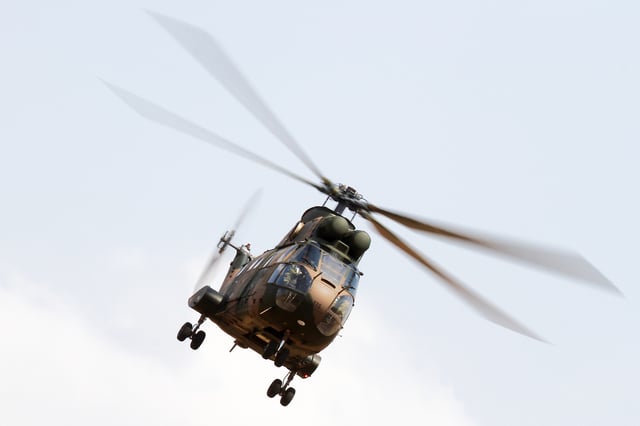
South African Air Force Puma, 2011
From 1972 onwards, Pumas operated by the SAAF were deployed on extended operations in neighboring Namibia and Angola during the Border War. During the first deployment to the Eastern Caprivi, one Puma crewmember became the first member of the SAAF to be awarded the Honoris Crux. The Puma was involved in normal trooping; rapid deployment during "follow up" operations; acting as radio relays; evacuation of casualties; rescuing downed aircrew; insertion of Special Forces; and large scale cross border operations such as Savannah, Uric, Protea, Super, and Modular.
The majority of South African Puma purchases, including spare parts, were made in advance of an anticipated United Nations embargo that was applied in 1977.[51] South Africa subsequently upgraded many of its Pumas, eventually arriving at the derived indigenous Atlas Oryx; external assistance and components were obtained via secretive transactions involving Portugal during the arms embargo era.[48][52]
In December 1979, South Africa's government acknowledged the presence of its military forces operating in Zimbabwe; Pumas were routinely used in support of the South African Army's ground forces.[53] In June 1980, 20 Pumas accompanied a force of 8,000 troops during a South African invasion of Angola in pursuit of nationalist SWAPO fighters.[54] In 1982, the government confirmed that 15 servicemen had been killed when a South African Puma was downed by SWAPO forces, it was one of the worst losses suffered in a single incident in the conflict.[55]
During the 1990s, clandestine efforts to purchase surplus SAAF Pumas were made by then-President Pascal Lissouba of the Republic of Congo, most likely intended for use in the Congolese Civil War.[56] When MTS Oceanos sank off the coast of South Africa in 1991, as many as 13 Pumas played crucial roles in the rescue efforts, winching 219 survivors to safety during bad weather conditions.[57]
United Kingdom
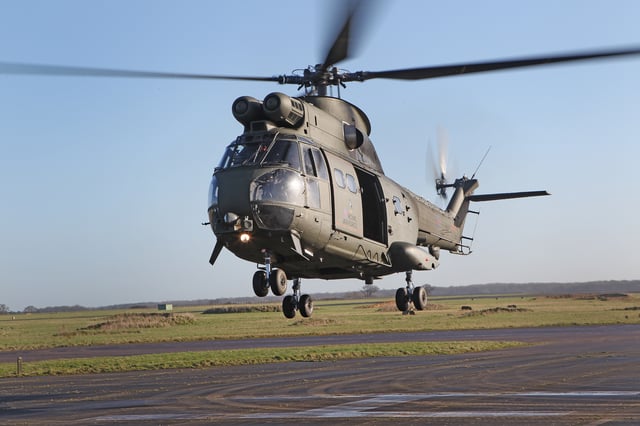
Upgraded British Puma HC2 in 2014
The first two Pumas for the Royal Air Force were delivered on 29 January 1971,[58][59] with the first operational squadron (33 Squadron) forming at RAF Odiham on 14 June 1971.[60] The RAF would order a total of 48 Puma HC Mk 1 for transport duties; during the Falklands War, an additional SA 330J formerly operated by Argentine Naval Prefecture was captured by British forces and shipped back to Britain and used as a RAF static training aid for several years. This SA 330J was later refurbished by Westland using parts from damaged RAF Puma XW215 and put into RAF service after a lengthy rebuild as ZE449.[61] The Puma became a common vehicle for British special forces, such as the SAS, and has been described as being "good for covert tasks".[62]
Between the early 1970s and the 1990s, RAF Pumas were based at RAF Odiham (33 Squadron and 240 OCU), RAF Gutersloh (230 Squadron) and No. 1563 Flight RAF at RAF Belize. During The Troubles it was also common for a detachment to be based at RAF Aldergrove in Northern Ireland. In 1994, 230 Squadron relocated to RAF Aldergrove to provide a permanent presence to augment the Westland Wessex of 72 Squadron. In 2009, 230 Squadron relocated to RAF Benson together with 33 Squadron from RAF Odiham.
Royal Air Force Pumas have also seen active service in Venezuela, Iraq, Yugoslavia, and Zaire.[63] Britain has frequently dispatched Pumas on disaster relief and humanitarian missions, such as during the 2000 Mozambique flood and the 1988 Jamaican flash flood;[64] and to conduct peacekeeping operations in regions such as Zimbabwe and the Persian Gulf.[63]
During the climax of the First Gulf War, a joint force of Pumas from 230 and 33 Squadrons proved decisive in rapidly mobilizing and deploying troops to prevent Iraqi troops from sabotaging the Rumaila oil field.[62] From the beginning of the Iraq War, between 2003 and 2009, RAF Pumas would be used to provide troop mobility across the theatre.[65] On 15 April 2007, two RAF Pumas collided during a special forces mission close to Baghdad, Iraq.[66] In November 2007, a Puma crashed during an anti-insurgent operation in Iraq; an inquest found the cause to be pilot error primarily, however the Ministry of Defence (MoD) was criticised for failing to equip RAF Pumas with night vision goggles and inadequate maintenance checks compromising safety, these shortcomings were addressed following the incident.[67]
In order to extend the type's service, six ex-South African SA 330L were purchased by Britain in 2002.[68] A programme to produce an extensive upgrade of the RAF's Pumas saw the first Puma HC Mk2 enter service in late 2012 and was completed by early 2014,[69] enabling the Puma fleet to remain in operational service until 2025. In 2008, it was envisaged that 30 aircraft would be upgraded,[70] this was subsequently cut to 22,[71] and was later revised upwards for a total of 24 HC Mk2 Pumas to be produced.[72] Upgrades include the integration of two Turbomeca Makila engines, new gearboxes and tail rotors, new engine controls, digital autopilot, a flight management system, an improved defensive aids suite, as well as ballistic protection for helicopter crew and passengers. The upgraded aircraft can transport double the payload over three times the range than its predecessor, and will be deployed by for tactical troop transport, as well as fast moving contingent combat and humanitarian operations.[73]
Civil
One of the largest and prominent operators of the type was Bristow Helicopters, where the Puma was regularly used for off shore operations over the North Sea.[9][74] during the 1970s, Bristow had sought to begin replacing their Sikorsky S-61 helicopters, the Puma was selected after a highly competitively-priced bid had been made by Aerospatiale; Puma G-BFSV was the first of the type to enter service with Bristow.[75] From 1979 onwards, the Puma formed the mainstay of the Bristow fleet;[76] the type took over the duties of Bristow's retiring Westland Wessex helicopters in 1981.[77] In 1982, Bristow introduced the more powerful Super Puma into service, supplementing their then-total fleet of 11 SA 330J Pumas.[78]
Erickson Inc. has operated four Pumas since 2014. They are used for VERTREP (vertical replenishment) to US Navy 5th and 7th Fleets.[79]
Variants
Aérospatiale versions
- SA 330APrototypes, originally called "Alouette IV".SA 330BInitial production version for theFrench Army Light Aviation. Powered by 884 kW (1,185 hp) Turbomeca Turmo IIIC4 engines. 132 purchased by France.[80]SA 330 OrchidéeSA 330 modified to carry an Orchidée battlefield surveillance radar system with a rotating underfuselage antenna, for the French Army. One demonstrator was built, flying in 1986. The Orchidée programme was cancelled in 1990, but the prototype rushed back into service in 1991 to serve in theGulf War, leading to production of a similar system based on theEurocopter Cougar.[81]SA 330CInitial export production version. Powered by 1,044 kW (1,400 hp) Turbomeca Turmo IVB engines.[82]SA.330EVersion produced by Westland Helicopters for the RAF under the designation Puma HC Mk. 1.SA.330FInitial civilian export production version with Turbomeca Turmo IIIC4 turboshaft engines.[83]SA.330GUpgraded civilian version with 1175 kW (1,575 hp) Turbomeca Turmo IVC engines.[83]SA.330HUpgraded French Army and export version with Turbomeca Turmo IVC engines and composite main rotor blades. Designated SA 330Ba by the French Air Force. All surviving French Army SA 330Bs converted to this standard.[83]SA.330JUpgraded civil transport version with composite rotor blades and with higher maximum takeoff weight.[84]SA.330LUpgraded version for "hot and high" conditions. Military equivalent to civil SA.330J.[84]SA.330SUpgraded SA 330L (themselves converted from SA 330C) version for the Portuguese Air Force. Powered byTurbomeca Makilaengines.[84]SA.330SMLebanese converted gunship version by mounting on hardened side-swivel mounts a single ADEN Mk 4/5 30mm revolver cannon on a modified pod and a pair of SNEB 68mm rocket launchers on each side .SA.330ZPrototype with "fenestron" tail rotor.[85]SA.331 Puma MakilaEngine test-bed for the AS.332 Super Puma series, powered by twoTurbomeca Makilaengines
Versions by other manufacturers
- Atlas Aircraft CorporationOryxThis is a remanufactured and upgraded SA 330 Puma built for theSouth African Air Force.IPTN NAS 330JThis is a version that was assembled by IPTN ofIndonesiaunder the local designation NAS 330J and the Aerospatiale designation of SA 330J. Eleven units were produced.IAR 330This is alicence-builtversion of the SA 330 Puma manufactured byIndustria Aeronautică RomânăofRomania. Designated as the SA 330L by Aerospatiale.IAR-330 Puma SOCAT24 modified for antitank warfare.IAR-330 Puma Naval3 modified for the Romanian Navy, using the SOCAT avionics.Westland Puma HC Mk 1SA 330E equivalent assembled by Westland Helicopters for the RAF, first flown on 25 November 1970. Several similarities to the SA 330B employed by the French Armed Forces. The RAF placed an initial order for 40 Pumas in 1967, with a further eight attrition replacement aircraft in 1979.[61]Westland Puma HC Mk 2Modified Puma HC Mk1s, total of 24 upgraded with more powerfulTurbomeca Makila1A1 engines, aglass cockpitand new avionics, secure communications and improved self-protection equipment.[69]
Operators
Current operators
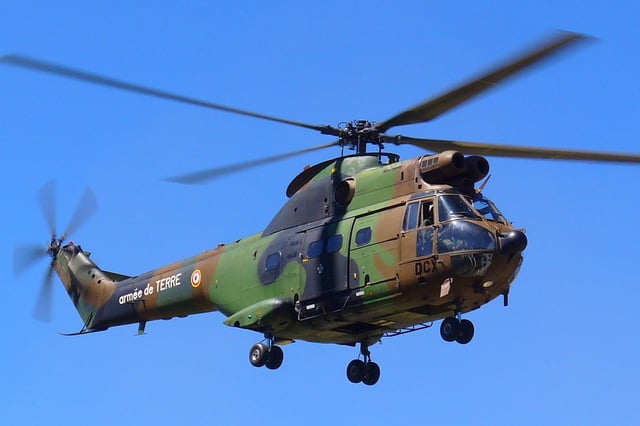
A French Army Aérospatiale Puma
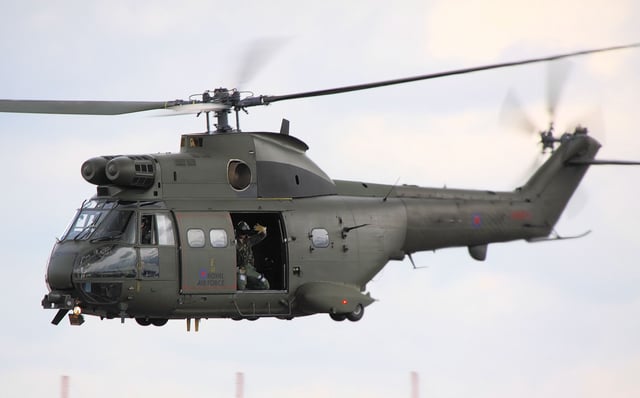
RAF Puma HC1 at Royal International Air Tattoo 2009
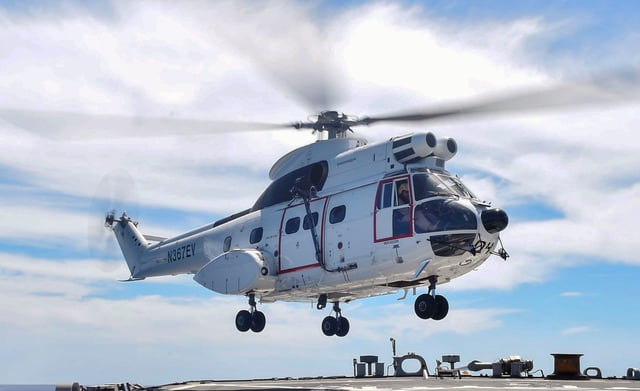
A contracted Puma resupplies the USS Benfold for the US Navy Sealift Command
Cameroon Air Force[86]
Chilean Army[86]
Democratic Congo Air Force[86]
Ecuadorian Army[86]
Military of Gabon[86]
Guinea Air Force[86]
Indonesian Air Force[86]
Kenya Air Force[86]
Kuwait Air Force[86]
Lebanese Air Force[86]
Malawi Army[86]
Royal Moroccan Air Force[86]
Royal Air Force of Oman[86]
Romanian Air Force (See IAR 330)
Romanian Navy (See IAR 330)
Former operators
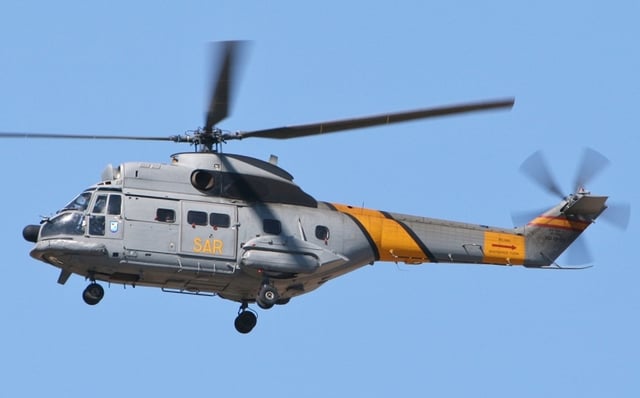
An Aérospatiale Puma of the Spanish Air Force
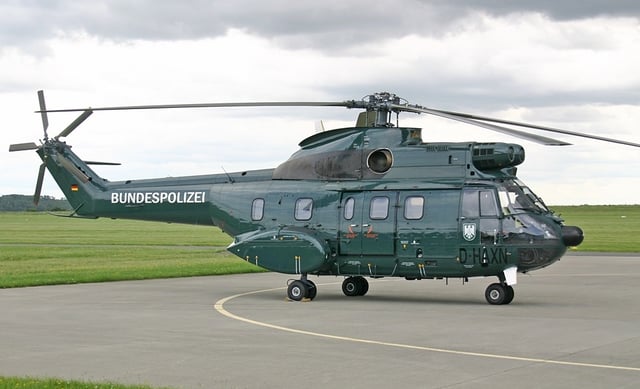
A SA 330 Puma formerly used by Germany's Bundespolizei
Algerian Air Force[87]
Gendarmerie[89]
Brazilian Air Force[90]
Chilean Air Force[91]
Ecuadorian Air Force[92]
Ethiopian Air Force[93]
Iraqi Air Force [94]
Irish Air Corps[95]
Mexican Air Force[96]
Nigerian Air Force [97]
Philippine Air Force[98]
Portuguese Air Force[99]
Senegalese Air Force[100]
South African Air Force[101]
Togolese Air Force[102]
Tunisian Air Force[103]
Specifications (SA 330H Puma)
Data from Jane's All The World's Aircraft 1976–77[105]
General characteristics
Crew: 3
Capacity: 16 passengers
Length: 18.15 m (59 ft 6½ in)
Rotor diameter: 15.00 m (49 ft 2½ in)
Height: 5.14 m (16 ft 10½ in)
Disc area: 177.0 m² (1,905 ft²)
Empty weight: 3,536 kg (7,795 lb)
Max takeoff weight: 7,000 kg (15,430 lb)
Powerplant: 2× Turbomeca Turmo IVC turboshafts, 1,175 kW (1,575 hp) each
Performance
Never exceed speed: 273 km/h (147 knots, 169 mph)
Maximum speed: 257 km/h (138 knots, 159 mph)
Cruise speed: 248 km/h (134 knots, 154 mph) econ cruise
Range: 580 km (313 nm, 360 mi)
Service ceiling: 4,800 m (15,750 ft)
Rate of climb: 7.1 m/s (1,400 ft/min)
Armament
Notable appearances in media
See also
Related development
Atlas Oryx
Denel Rooivalk
Eurocopter AS332 Super Puma
Eurocopter AS532 Cougar
Eurocopter EC225 Super Puma Mk II+
Eurocopter EC725 Super Cougar
IAR 330
Aircraft of comparable role, configuration and era
Mil Mi-8
NH 90
Related lists
List of rotorcraft


